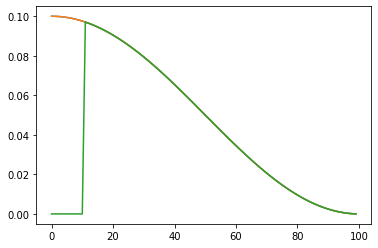PyTorch Version: 1.11
I want to resume my learning rate after my training is terminated.
Here’s a toy example:
import torch.nn as nn
from torch.optim import SGD
from torch.optim.lr_scheduler import CosineAnnealingLR
n = 100
net = nn.Conv2d(3, 3, 1)
opt = SGD(net.parameters(), 0.1)
s = CosineAnnealingLR(opt, n, last_epoch=-1)
ckpt = "s.pt"
s_lr = []
for _ in range(s.last_epoch, n):
lr = s.get_last_lr()
s_lr.extend(lr)
s.step()
if _ == 10:
torch.save(s.state_dict(), ckpt)
Now I resume it by two ways. Note that my program is terminated. All object should be instanced again.
# Method 1
n = 100
net = nn.Conv2d(3, 3, 1)
opt = SGD(net.parameters(), 0.1)
ckpt = "s.pt"
state_dict = torch.load(ckpt)
s = CosineAnnealingLR(opt, n, last_epoch=state_dict["last_epoch"])
s.load_state_dict(state_dict)
s_lr = []
for _ in range(s.last_epoch, n):
lr = s.get_last_lr()
s_lr.extend(lr)
s.step()
print(s_lr[:3])
It throws an error param 'initial_lr' is not specified in param_groups[0] when resuming an optimizer. And
# Method 2
n = 100
net = nn.Conv2d(3, 3, 1)
opt = SGD(net.parameters(), 0.1)
ckpt = "s.pt"
state_dict = torch.load(ckpt)
s = CosineAnnealingLR(opt, n, last_epoch=-1)
s.load_state_dict(state_dict)
s_lr = []
for _ in range(s.last_epoch, n):
lr = s.get_last_lr()
s_lr.extend(lr)
s.step()
print(s_lr[:3])
It print a wrong learning rate [0.09704403844771128, 0.09942787402278414, 0.09880847171860509], which 0.099 > 0.097.
What is the proper way of resuming a scheduler?
NOTE: I have checked What is the proper way of using last_epoch in a lr_scheduler? but it could not solve my problem.

